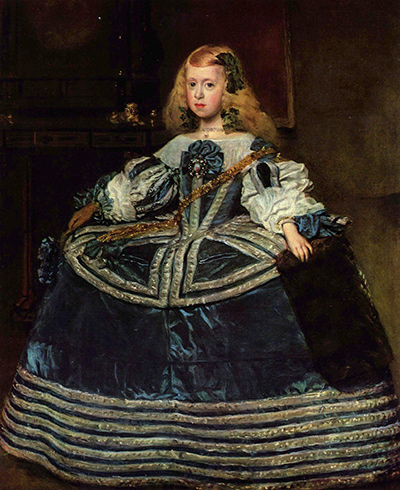Infanta Margarita Teresa in a Blue Dress
Infanta Margarita Teresa in a Blue Dress is one of the most popular portraits by Diego Velazquez. The 127x107 cm portrait executed in oil on canvas was painted in 1659, a year before Velazquez passed away; thus, this was one of the last paintings done by the Spanish painter.

Velazquez had painted Margarita Teresa earlier too, in his ‘Las Meninas’ painting. From a young age, Teresa was promised to her uncle (and the future Holy Roman emperor) Leopold I.
The painting Infanta Margarita Teresa in a Blue Dress was created and sent to Leopold as a gift on the same year it was created to show him what his young fiancé looked like. Five portraits of Teresa has been created by Velazquez on the orders of her father for recording the bride’s development and this one is considered to be possibly the best out of all.
Teresa married at the age of 15, the wedding, which took place in the Viennese court in 1666 is a perfect depiction of the zenith of Baroque culture. The wedding festivities included operas, equestrian ballet, cannon fire and grand firework displays. Six years later, Teresa died at a young age of 21 after the birth of her sixth child.
The subject of the painting, i.e. the infanta, is only eight years old in the painting. She wears a solemn expression with her blue silk dress adorned with silver borders. What captures one’s attention about the painting is the vast expanse of the voluminous crinoline. Another striking characteristic of the painting would be the wide lace collar and the trimmed borders of the dress. On her left hand, Teresa holds a brown fur muff which is probably a gift to her from the Court in Vienna.
Young Teresa looks very appealing and pretty in the picture, her pale countenance is enhanced by the contrasting blue and cool metallic silver tones of her dress. Also, it brings out her blue eyes very well. There is a high console table and a mirror behind her in the background. Velazquez manages to strike a perfect balance here, i.e. he maintains the formal etiquette obligatory for a court portrait, and hence doesn’t end up offending his patrons and at the same time the painting captures the naïve charm of the child in a timeless manner. After all, the painting still resonates with the viewer even today!
In Infanta Margarita Teresa in a Blue Dress painting, Velazquez used the technique of loose brushstrokes. However, these do not look haphazard, but instead they fuse into coherence when viewed from a distance. Being a seasoned and experienced painter, Velazquez has managed to not just fulfil his duty to paint an official portrait but also depict Teresa in a lifelike manner.
Velazquez artistic virtuosity is a combination of a swift hand and a sure eye. He breathed new life into his court portraits, which were a refreshing change from the long stagnant convention and style used for making such portraits. As mentioned earlier, the Spanish Baroque styled painting was donated to the Court in Vienna in 1659 but currently it is housed in the Kunsthistorisches Museum in Vienna.